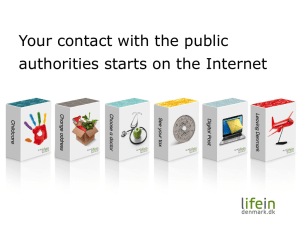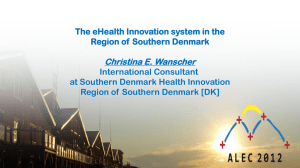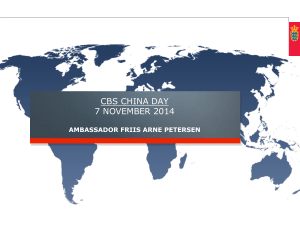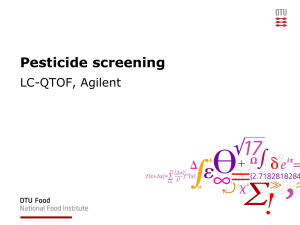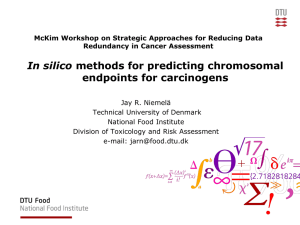New Opportunities for safer food
advertisement
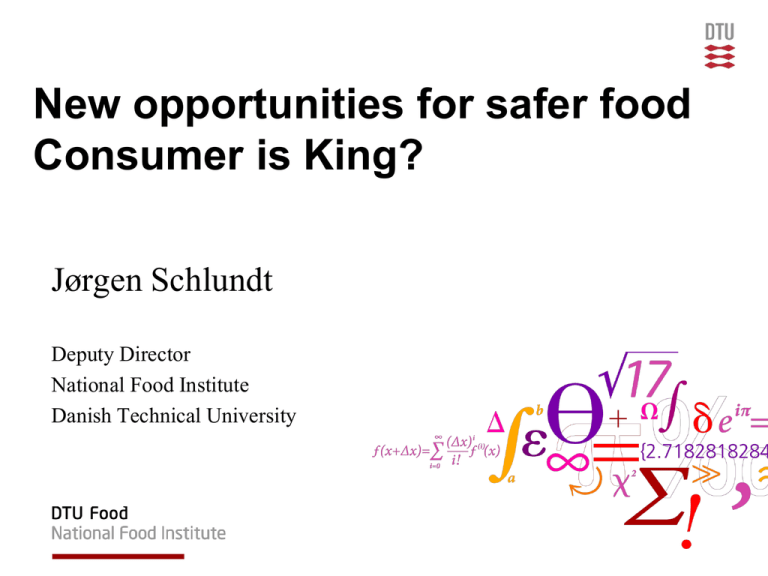
New opportunities for safer food Consumer is King? Jørgen Schlundt Deputy Director National Food Institute Danish Technical University Disease burden from Diarrhoea Food- and Water-borne Disease Incidence approximately 4,000,000,000 cases per year Deaths approximately 1,800,000 per year (mostly children) Remember Significant numbers of other food-borne diseases (caused by both microorganisms and chemical substances) National Food Institute, Technical University of Denmark Consumers rule !? • In the 70’ies and 80’ies the definition of food safety policies was the responsibility of authorities and food industries, presiding over a steady decline in both safety and quality of the food we eat. • Change has happened since then, but major changes in food safety systems stem from food scandals (BSE in Europe and E. coli in USA) – i.e. only when consumers were made aware of the problems • In future systems, relevant data – on food and disease - will be transparent and consumers will be at the table when decisions are made. • This will only make a difference if consumers organizations are ready to take up this responsibility. National Food Institute, Technical University of Denmark Consumer responsibility !? • A typical old-time statement would for instance be that “… most foodborne diseases could be avoided if consumers did the right thing in the kitchen!!”. • While there is a clear need to improve consumers behavior through consumer education (e.g. via the WHO ‘Five Keys to Safer Food’), it is clearly wrong to suggest responsibility for safe food is with the consumer: this is a joint responsibility that lies primarily with the Producer. • The crucial, new role of consumers as stakeholders also in defining policies should open up a whole new playing field for Consumers Organizations, influencing food production and food safety systems to continuously improve , making more people healthy and fewer sick National Food Institute, Technical University of Denmark Consumer Organizations’ opportunities • Consumers Organizations will have significant new opportunities in relation to the new conceptual framework being introduced all over the world for food safety: The Risk Analysis framework • In this framework Consumers organizations are considered important stakeholders in defining food safety policies and solutions. • This is a significant departure from the previous roles for consumers within old-time food safety systems National Food Institute, Technical University of Denmark Risk Analysis Risk Assessment FAO/WHO Expert Bodies (Independent science) Risk Management FAO/WHO Codex Alimentarius Commission Risk Communication Interactive exchange of information and opinions concerning risks National Food Institute, Technical University of Denmark Stakeholders – part of the problem? – part of the solution? From a framework developed by consumer organizations with WHO/FAO, 2005: available at www.safefoodinternational.org Public involvement throughout the risk analysis process is essential in order to understand factors which can affect people's willingness to accept a particular risk. It is essential that consumers are involved in determining an acceptable level of risk. Communication among food safety authorities, consumers and the food industry should be a vital and continuous function of a national food safety program Risk management should include clear, interactive communication with consumers and other interested parties in all aspects … and a major function is the process by which opinion essential to effective risk management is incorporated into the decision. National Food Institute, Technical University of Denmark Consumer as stakeholder National Food Institute Independent science Food Authority Management – inclusion of stakeholders Risk Communication Interactive exchange of information and opinions concerning risks – including all stakeholders National Food Institute, Technical University of Denmark Looking where the data is in stead of Looking for the right data National Food Institute, Technical University of Denmark Safety cannot be achieved by senseless testing Lot: 0.1% defectives 10 samples: Probability of detection ~ 1% National Food Institute, Technical University of Denmark Start by linking disease and food: Principle of Salmonella Source attribution model Compare the number of (reported) human cases caused by different Salmonella subtypes with the distribution of Salmonella subtypes isolated from the various food (-animal) sources National Food Institute, Technical University of Denmark 100 Source: Danish Zoonoses Centre, DTU National Food Institute Estimated number of human cases per 100,000 Trends and sources of human salmonellosis in Denmark, 1988-2007 80 60 40 20 0 88 89 90 91 92 93 94 95 96 Broilers Total Import National Food Institute, Technical University of Denmark 97 98 99 00 Pork Total cases 01 02 03 Table eggs 04 05 06 07 When describing risk: often ignores the public outrage factor pays too little attention to the relative nature of risk National Food Institute, Technical University of Denmark It takes two to communicate Predict, discuss and decide risk reduction from sensible action National Food Institute, Technical University of Denmark The unbearable weight of Status Quo Some Danish examples show clearly that significant reduction is possible for specific pathogens – Setting and achieving Targets for Reduction Part of the explanation of success lies in involvement of stakeholders (both industry and consumers) Who is responsible for driving change Authorities? Industry? Consumer NGO’s? Status Quo should not be an option National Food Institute, Technical University of Denmark Is this possible to communicate? (we are not going for zero!) Traditionally Targets have not been considered easily ‘communicable’ within food safety (although clearly used in many other areas – e.g. environment) On the other hand the EU system has clearly formulated targets in food safety areas (Zoonosis Directive) and USA has tried target driven intervention at slaughterhouse level (Salmonella in pigs) Nevertheless a target discussion is now virtually absent from the international scene, which has for some years been dominated by generic ‘hygienic guidelines’ discussions without any audacity Consumers need to weigh in! National Food Institute, Technical University of Denmark Setting Targets to reduce foodborne disease levels The Food safety Win-Win Improved food safety less illness, medical and social costs, poverty Improved Food trade international trade capability safe national trade Improved health less illness, medical and social costs, poverty Economic Development National Food Institute, Technical University of Denmark Global approach – Global improvement • Lowering the global disease burden is possible through international standards based on health considerations • Improving economic development is possible through international trade of safer food • • Help to developing countries should not be given in a way costing lives in importing countries (lowering standards) but in a way that improves food safety both in exporting and importing country (technical assistance as per WTO/SPS agreement (Sanitary and PhytoSanitary)) National Food Institute, Technical University of Denmark Prevention in one global food market • Foodborne disease will not be prevented through end-product testing or through border control alone • New – and more efficient - food safety systems could attempt a focus on preventative efforts as close to the source as possible • New agricultural products will most likely affect both nutrition and food safety globally in the future reinforcing the need to Include Consumers globally in Policy communication and decisions National Food Institute, Technical University of Denmark


